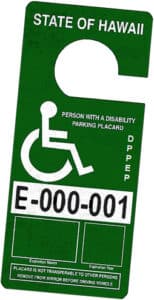
Transportation Equity
Transportation Equity aims to ensure that all community members’ needs
Share:
Share:
In 2016, a study bythe Massachusetts Inspector General>estimated that disability parking permit misuse at parking meters was annually costing the City of Boston between $1 million and $3.6 million in lost revenue each year. On the opposite coast, a similar study concluded that the City and County of San Francisco was losing $22 million in annual parking meter fees to disability parking permit use, with a portion of that undoubtedly parking permit misuse.

The State of Hawaii addressed these issues by requiring the physician to certify a condition and a functional impact on the application form, requiring a $12 replacement fee if a placard was reported lost or confiscated for misuse, and reducing the number of long-term placards that could be issued to an applicant from two to one. But these measures had only a limited impact. DCAB reasoned that once an applicant fraudulently obtained a disability parking permit to avoid parking fees, they would likely use it to park illegally in reserved accessible parking spaces. This would occur especially in large parking lots where the proximity of a reserved accessible parking space to a building’s entrance would tempt them to use the permit. A survey of permittees revealed that the larger a parking lot, the harder it was to find an available, accessible parking space.
While the Hawaii Revised Statutes limits the parking meter fee exemption to 2.5 hours or the maximum time the meter allows, whichever is longer, it was easy to observe vehicles parked more than the time limits—often all day, since there was sparse enforcement of the time limits. Those vehicles likely belonged to employees or residents of nearby offices and apartment buildings. Off-street parking in downtown Honolulu may cost up to $300 a month, so a strong financial incentive existed for misuse. The abuse of the time limit was likely more prevalent than the fraudulent use of a permit. An audit of the City and County of Honolulu’s bike share program revealed that several of the City’s on-street parking meters were only generating between 10%-20% of their projected maximum revenue. While some of that extreme shortfall was due to a space being unoccupied or because a vehicle had some sort of parking permit that waives the fee, disability parking permit abuse was a large contributing factor.
The states of Michigan, Illinois, Oregon, and Colorado previously implemented a tiered system of disability parking permits, where only a special placard provided the dual benefit of allowing the permittee to park in a reserved accessible space or in a space where payment is required without payment of that fee. The underlying premise is that a parking fee exemption should be related to barrier removal, not a financial subsidy. To qualify, an applicant must have a disability that prevents the applicant from reaching or operating a parking meter, and the applicant must be able to drive themselves (otherwise, the other person in the vehicle can pay the fee). These states informed DCAB that only about 3% to 10% of their applicants qualified for the special placard. They continue to issue their other applicants disability parking permits that allow them to park a vehicle in a reserved accessible parking space.
DCAB decided that a two-tiered system would be suitable for Hawaii, and in 2018 a bill was introduced at the State Legislature to amend the state’s disability parking law, Hawaii Revised Statutes Chapter 291, Part III, Parking for Disabled Persons. This first attempt to amend the law failed. But it was a valuable exercise that allowed DCAB to learn what the public’s objections were and which elected officials required outreach and detailed dialogue. In advance of the following legislative session, DCAB refined its list of individuals and organizations that were willing to submit testimony in support of the legislation, including county transportation and parking enforcement departments. DCAB obtained confirmation from the State Department of the Attorney General that the new law would not run afoul of the Americans with Disabilities Act as some had alleged. The reintroduced bill passed the Legislature and was signed into law by Governor David Y. Ige on June 7, 2019.
The effective date of the amended law was set as July 1, 2021, to allow time for administrative rulemaking and procurement of a new green-colored placard, formally designated as the Disabled Paid Parking Exemption Permit (DPPEP). In addition to its green color (temporary placards are red, and long-term placards are blue), “DPPEP” is prominently displayed vertically on the placard. This is to assist parking enforcement personnel in low light situations and for those who are color blind. To qualify for the DPPEP, the applicant must possess a valid driver’s license and be certified by a Hawaii licensed physician or an advanced practice registered nurse that (1) the applicant has a qualifying mobility disability and (2) at least one of the following three conditions: (a) The applicant cannot reach above the applicant’s head to a height of 42 inches from the ground due to a lack of finger, hand, or upper extremity strength or mobility; (b) The applicant cannot approach a parking meter due to the use of a wheelchair or other mobility device; (c) The applicant cannot manage, manipulate, and insert coins, bills, or cards in a parking meter or pay station due to a lack of fine motor control in both hands.
This long delay in the effective date was fortuitous as the COVID-19 pandemic slowed these preparations down. DCAB successfully began issuing DPPEPs on July 1, 2021. Several efforts were made to inform the public. Information about the change was handed out with every disability parking permit issued. Every permittee who had an email on file with DCAB was contacted. DCAB’s Executive Director Kirby Shaw gave multiple interviews to local television and newspapers. And most directly, the parking enforcement agencies agreed to forgo issuing any citations for the first 45 days and instead placed warning flyers on vehicles displaying a disability parking permit at parking meters.
There were some negative reactions from permittees with legacy placards as they became aware of the change. Some permittees lamented the financial impact the new law would have on them, especially older people on a fixed income. But three specific geographical areas generated the bulk of the complaints. One was at Kapiolani Park, located across from Waikiki Beach. Many permittees would use the metered spaces without payment and walk across the road to go surfing or swimming. There are only a few free public parking spaces along the beach park, including reserved accessible spaces. The second area was at Straub Hospital and Kaiser Permanente Medical Facility in Honolulu. While both facilities have large off-street parking lots, they charge for parking. So many permittees would park without payment in the metered spaces along King Street, which fronts both locations. Because King Street becomes a no-parking zone at 3:30 p.m., this had a secondary effect of pushing permittees to make their appointments in the morning. And the third area was a Kailua senior residential facility that the City and County of Honolulu had exempted from providing the required minimum number of off-street parking spaces under the theory that the residents would not own cars. The few spaces that were designated for residential parking were part of a larger metered public parking lot. It became clear that many residents had been using their disability parking permits to park without payment in the public metered spaces 24 hours a day. DCAB advised these residents to petition the City and County to convert some of the public parking spaces to paid residential parking. A second surge in negative public reaction occurred after the 45-day grace period expired and citations were issued. Parking enforcement attached the warning flyers to the citations so permittees would understand the reason for the citation. The flyers provided DCAB’s contact information.
In the 18 months since the law took effect, only 400 applicants have qualified for the DPPEP, representing roughly half of 1% of the total disability parking permits in use. The City and County of Honolulu, which has approximately 70% of the state’s population, reported parking meter revenue of $4.05 million in fiscal year 2021. The meter revenue increased to $5 million in fiscal year 2022, the first full year the DPPEPs were in use and the legacy placards no longer conferred a meter fee exemption.
DCAB encourages all states that currently provide free parking to instead implement a tiered system of disability parking permits. Please feel free to contact DCAB at dcab@doh.hawaii.gov or (808) 586-8121 if you would like more information. Mahalo! ◆
Bryan K. Mick is Program & Policy Development Staff Coordinator for the State of Hawaii’s Disability and Communication Access Board.

Transportation Equity aims to ensure that all community members’ needs


Transportation equity requires understanding the needs of every person potentially
Parking & Mobility is IPMI’s flagship publication, covering the news, trends, analysis, technologies, and people of the parking and mobility industry, and how it affects and influences communities around the world.
| Cookie | Duration | Description |
|---|---|---|
| cookielawinfo-checkbox-advertisement | 1 year | Set by the GDPR Cookie Consent plugin, this cookie is used to record the user consent for the cookies in the "Advertisement" category . |
| cookielawinfo-checkbox-analytics | 11 months | This cookie is set by GDPR Cookie Consent plugin. The cookie is used to store the user consent for the cookies in the category "Analytics". |
| cookielawinfo-checkbox-functional | 11 months | The cookie is set by GDPR cookie consent to record the user consent for the cookies in the category "Functional". |
| cookielawinfo-checkbox-necessary | 11 months | This cookie is set by GDPR Cookie Consent plugin. The cookies is used to store the user consent for the cookies in the category "Necessary". |
| cookielawinfo-checkbox-others | 11 months | This cookie is set by GDPR Cookie Consent plugin. The cookie is used to store the user consent for the cookies in the category "Other. |
| cookielawinfo-checkbox-performance | 11 months | This cookie is set by GDPR Cookie Consent plugin. The cookie is used to store the user consent for the cookies in the category "Performance". |
| CookieLawInfoConsent | 1 year | Records the default button state of the corresponding category & the status of CCPA. It works only in coordination with the primary cookie. |
| elementor | never | This cookie is used by the website's WordPress theme. It allows the website owner to implement or change the website's content in real-time. |
| viewed_cookie_policy | 11 months | The cookie is set by the GDPR Cookie Consent plugin and is used to store whether or not user has consented to the use of cookies. It does not store any personal data. |
| Cookie | Duration | Description |
|---|---|---|
| _ga | 2 years | The _ga cookie, installed by Google Analytics, calculates visitor, session and campaign data and also keeps track of site usage for the site's analytics report. The cookie stores information anonymously and assigns a randomly generated number to recognize unique visitors. |
| _ga_02PMHW8YWC | 2 years | This cookie is installed by Google Analytics. |
| _ga_LC0QJJHM3J | 2 years | This cookie is installed by Google Analytics. |
| _ga_V9KYTSBYT2 | 2 years | This cookie is installed by Google Analytics. |
| iutk | 5 months 27 days | This cookie is used by Issuu analytic system to gather information regarding visitor activity on Issuu products. |
| Cookie | Duration | Description |
|---|---|---|
| mc | 1 year 1 month | Quantserve sets the mc cookie to anonymously track user behaviour on the website. |
| Cookie | Duration | Description |
|---|---|---|
| ultp_view_1052 | 1 day | No description |
| ultp_view_1058 | 1 day | No description |
| ultp_view_1060 | 1 day | No description |
| ultp_view_1064 | 1 day | No description |
| ultp_view_1068 | 1 day | No description |
| ultp_view_1070 | 1 day | No description |
| ultp_view_1072 | 1 day | No description |
| ultp_view_1078 | 1 day | No description |
| ultp_view_1082 | 1 day | No description |
| ultp_view_1088 | 1 day | No description |
| ultp_view_1100 | 1 day | No description |
| ultp_view_1103 | 1 day | No description |
| ultp_view_1114 | 1 day | No description |
| ultp_view_1118 | 1 day | No description |
| ultp_view_1122 | 1 day | No description |
| ultp_view_1125 | 1 day | No description |
| ultp_view_1130 | 1 day | No description |
| ultp_view_1132 | 1 day | No description |
| ultp_view_1135 | 1 day | No description |
| ultp_view_1541 | 1 day | No description |
| ultp_view_1554 | 1 day | No description |
| ultp_view_1557 | 1 day | No description |
| ultp_view_1560 | 1 day | No description |
| ultp_view_1563 | 1 day | No description |
| ultp_view_1568 | 1 day | No description |
| ultp_view_1572 | 1 day | No description |
| ultp_view_1576 | 1 day | No description |
| ultp_view_1580 | 1 day | No description |
| ultp_view_2305 | 1 day | No description |
| ultp_view_2321 | 1 day | No description |
| ultp_view_2338 | 1 day | No description |
| ultp_view_2342 | 1 day | No description |
| ultp_view_259 | 1 day | No description |
| ultp_view_270 | 1 day | No description |
| ultp_view_275 | 1 day | No description |
| ultp_view_286 | 1 day | No description |
| ultp_view_3074 | 1 day | No description |
| ultp_view_3115 | 1 day | No description |
| ultp_view_3334 | 1 day | No description |
| ultp_view_3336 | 1 day | No description |
| ultp_view_3338 | 1 day | No description |
| ultp_view_3340 | 1 day | No description |
| ultp_view_3346 | 1 day | No description |
| ultp_view_3354 | 1 day | No description |
| ultp_view_3361 | 1 day | No description |
| ultp_view_3367 | 1 day | No description |
| ultp_view_365 | 1 day | No description |
| ultp_view_367 | 1 day | No description |
| ultp_view_38 | 1 day | No description |
| ultp_view_3846 | 1 day | No description |